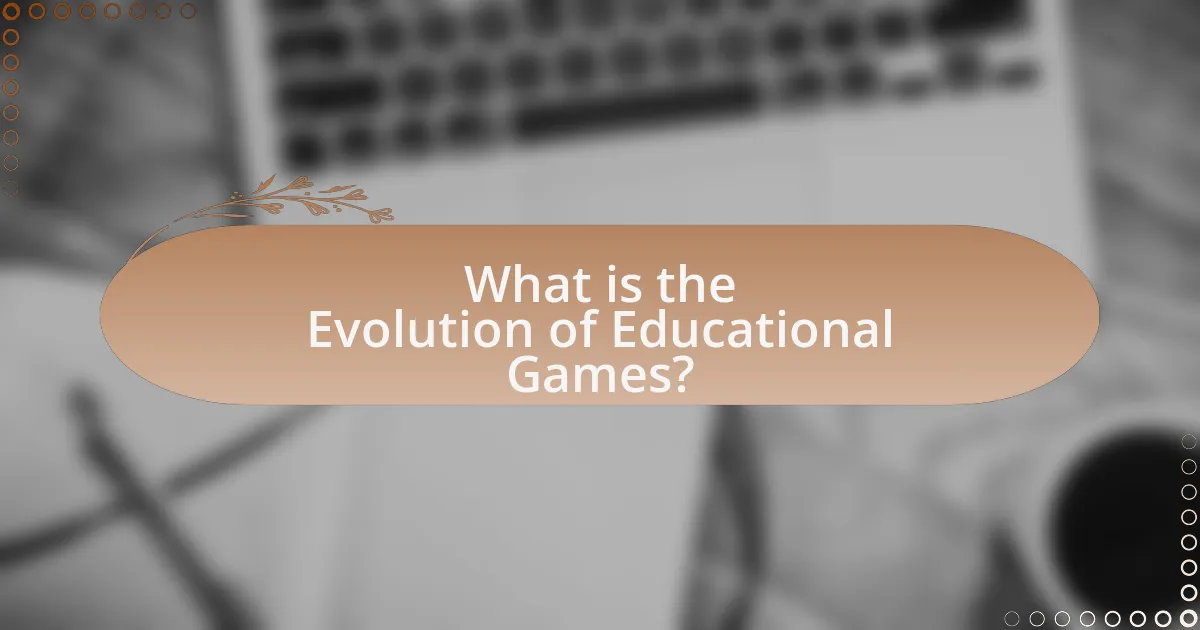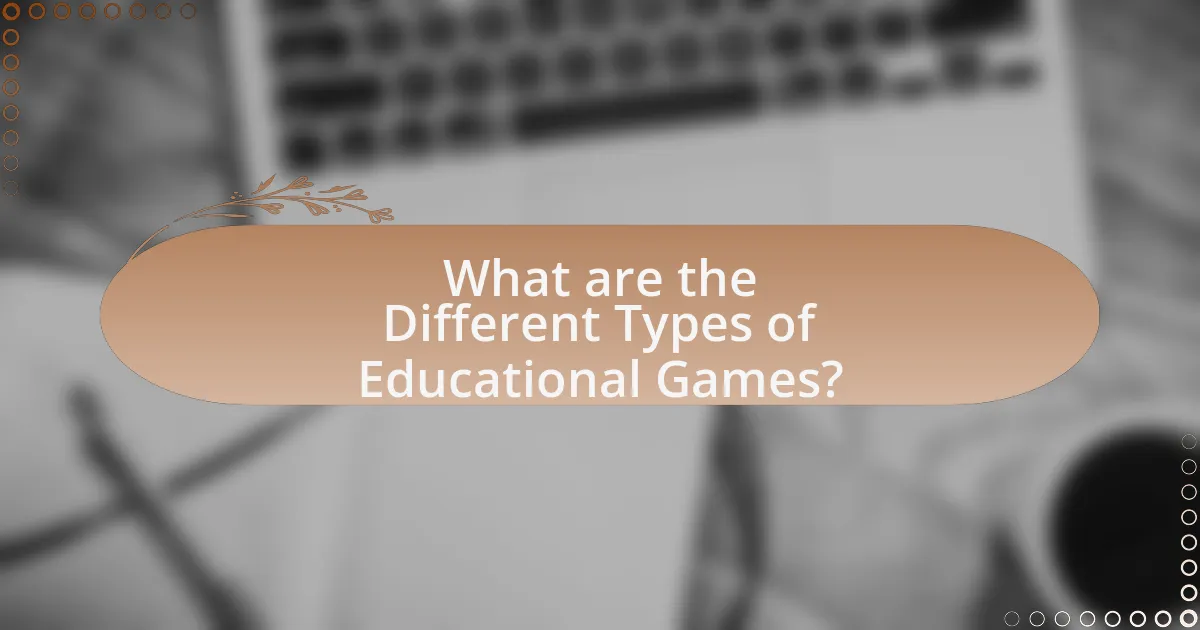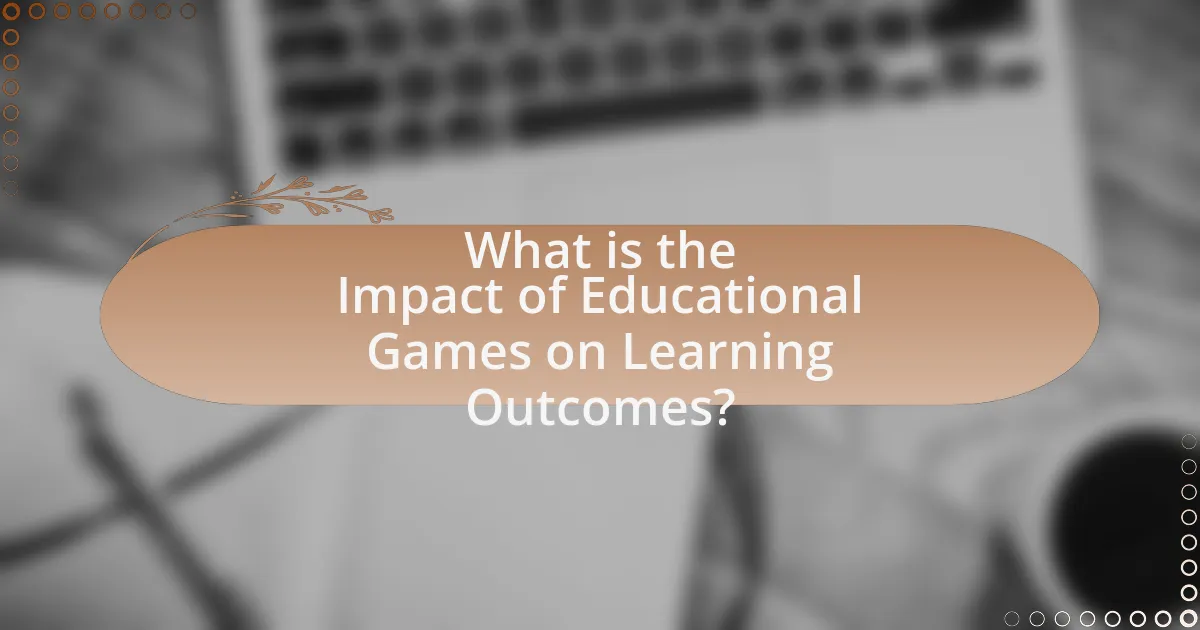The article examines the evolution of educational games and their significant impact on learning outcomes. It traces the development of these games from simple board games in the early 20th century to complex digital experiences facilitated by advancements in technology, including the internet and mobile devices. Key milestones in the history of educational games are highlighted, along with the influence of educational theories on game design. The article also categorizes different types of educational games, discusses the advantages of digital versus non-digital formats, and presents evidence supporting the effectiveness of educational games in enhancing student engagement, motivation, and retention of information. Additionally, it addresses challenges educators face in implementing these games and offers best practices for integrating them into curricula.

What is the Evolution of Educational Games?
The evolution of educational games began in the early 20th century with simple board games designed to teach basic skills, such as arithmetic and language. Over time, the introduction of technology transformed educational games, starting with computer-based games in the 1980s that incorporated interactive elements and multimedia. By the 2000s, the rise of the internet and mobile devices led to the development of online educational platforms and apps, allowing for more engaging and accessible learning experiences. Research indicates that these advancements have significantly improved learning outcomes, with studies showing that game-based learning can enhance motivation and retention of information, as evidenced by a 2014 meta-analysis published in the Journal of Educational Psychology, which found that students using educational games scored higher on assessments compared to those who did not.
How have educational games changed over time?
Educational games have evolved significantly from simple, text-based formats to complex, interactive digital experiences. Initially, educational games were primarily board games or basic computer programs focused on rote memorization and skill drills. Over time, advancements in technology have introduced multimedia elements, such as graphics, sound, and interactivity, enhancing engagement and learning effectiveness. For instance, the rise of the internet and mobile devices has enabled the development of online platforms and apps that offer personalized learning experiences, adaptive challenges, and real-time feedback. Research indicates that these modern educational games can improve motivation and retention rates, with studies showing that students using game-based learning scored higher on assessments compared to traditional methods.
What were the earliest forms of educational games?
The earliest forms of educational games included simple board games and card games designed to teach basic skills such as counting, reading, and social interaction. For instance, games like “The Game of Life,” created in the 1860s, aimed to simulate real-life scenarios and decision-making processes, while “Chutes and Ladders,” originating from ancient India, was used to impart moral lessons and basic counting skills. These games laid the groundwork for integrating play into learning, demonstrating that engagement through games can enhance educational outcomes.
How did technology influence the development of educational games?
Technology significantly influenced the development of educational games by enabling interactive and immersive learning experiences. The advent of personal computers in the 1980s allowed for the creation of software that could engage students through gameplay, making learning more appealing. For instance, the introduction of the internet in the 1990s facilitated online multiplayer educational games, which fostered collaboration and competition among learners. Additionally, advancements in mobile technology have led to the proliferation of educational apps, allowing learning to occur anytime and anywhere. Research by the Joan Ganz Cooney Center in 2013 highlighted that children who engaged with educational games showed improved problem-solving skills and higher retention of information, demonstrating the effectiveness of technology in enhancing educational outcomes.
What are the key milestones in the history of educational games?
The key milestones in the history of educational games include the development of “Tennis for Two” in 1958, which was one of the first computer-based games, and “Oregon Trail” in 1971, which introduced simulation-based learning. In 1980, “Reader Rabbit” emerged as a significant educational software for early literacy. The 1990s saw the rise of interactive CD-ROMs, with titles like “Carmen Sandiego” enhancing geography education. The introduction of online educational games in the early 2000s, such as “Kahoot!” and “Minecraft: Education Edition,” further revolutionized learning by promoting engagement and collaboration. These milestones demonstrate the evolution of educational games from simple simulations to complex, interactive platforms that significantly impact learning outcomes.
Which educational games were pivotal in shaping the industry?
The educational games that were pivotal in shaping the industry include “Oregon Trail,” “Math Blaster,” and “Carmen Sandiego.” “Oregon Trail,” released in 1971, introduced interactive storytelling and decision-making in a historical context, influencing future educational game design. “Math Blaster,” launched in 1983, combined gameplay with math skills, demonstrating the effectiveness of gamification in learning. “Carmen Sandiego,” first released in 1985, emphasized geography and critical thinking, becoming a model for educational content integrated with engaging narratives. These games collectively set foundational standards for educational gaming, proving that entertainment can effectively enhance learning outcomes.
How have educational theories impacted game design?
Educational theories have significantly influenced game design by integrating principles of learning and engagement into gameplay mechanics. For instance, constructivist theories, which emphasize active learning through experience, have led to the creation of games that encourage exploration and problem-solving, such as “Minecraft” and “Portal.” These games allow players to construct knowledge through interaction with the game environment, aligning with the educational principle that learners build understanding through hands-on experiences. Additionally, behaviorist theories have shaped game design through reward systems, where immediate feedback and reinforcement motivate players, as seen in games like “Kahoot!” and “Quizlet.” This application of educational theories in game design not only enhances player engagement but also improves learning outcomes by fostering critical thinking and collaboration skills.

What are the Different Types of Educational Games?
Educational games can be categorized into several types, including simulation games, puzzle games, role-playing games, quiz games, and board games. Simulation games replicate real-world scenarios, allowing players to practice skills in a safe environment, such as flight simulators used in pilot training. Puzzle games challenge cognitive skills and problem-solving abilities, often incorporating math or logic, like Sudoku or math-based apps. Role-playing games engage players in character-driven narratives, enhancing creativity and social skills, as seen in games like Dungeons & Dragons. Quiz games test knowledge across various subjects, promoting retention and recall, exemplified by platforms like Kahoot. Lastly, board games, such as Scrabble or Monopoly, encourage strategic thinking and collaboration, reinforcing learning through interactive play. Each type of educational game serves distinct learning objectives, contributing to improved educational outcomes.
How do digital and non-digital educational games differ?
Digital educational games utilize technology, such as computers or tablets, to deliver interactive learning experiences, while non-digital educational games rely on physical components like cards, boards, or other tangible materials. Digital games often provide instant feedback, adaptive learning paths, and multimedia elements that enhance engagement and cater to diverse learning styles. In contrast, non-digital games promote face-to-face interaction and can foster social skills through collaborative play. Research indicates that digital games can improve cognitive skills and retention rates, with studies showing that students using digital educational games scored 20% higher on assessments compared to those using traditional methods.
What are the advantages of digital educational games?
Digital educational games enhance learning by promoting engagement, improving retention, and fostering critical thinking skills. These games create interactive environments that motivate students to participate actively in their learning process. Research indicates that students who engage with educational games demonstrate higher levels of knowledge retention compared to traditional learning methods, with studies showing a 20% increase in retention rates. Additionally, digital educational games often incorporate adaptive learning technologies, allowing for personalized experiences that cater to individual learning paces and styles, further enhancing educational outcomes.
In what ways do non-digital games still play a role in education?
Non-digital games play a significant role in education by enhancing critical thinking, teamwork, and problem-solving skills among students. These games, such as board games and role-playing activities, foster engagement and motivation, making learning more interactive. Research indicates that non-digital games can improve cognitive abilities; for instance, a study published in the Journal of Educational Psychology found that students who participated in game-based learning showed a 20% increase in retention of information compared to traditional teaching methods. Additionally, non-digital games promote social interaction, allowing students to develop communication skills and emotional intelligence, which are essential for collaborative learning environments.
What genres of educational games exist?
Educational games exist in several genres, including simulation, puzzle, role-playing, trivia, and adventure. Simulation games allow players to experience real-world scenarios, enhancing practical skills; puzzle games focus on problem-solving and critical thinking; role-playing games encourage creativity and decision-making through character development; trivia games test knowledge across various subjects; and adventure games often combine storytelling with exploration, promoting engagement and learning. Each genre contributes uniquely to educational outcomes by fostering different cognitive skills and knowledge retention.
How do simulation games enhance learning experiences?
Simulation games enhance learning experiences by providing immersive, interactive environments that facilitate experiential learning. These games allow learners to engage in realistic scenarios where they can apply theoretical knowledge in practical contexts, thereby reinforcing understanding and retention. Research indicates that simulation games improve critical thinking and problem-solving skills; for instance, a study published in the Journal of Educational Psychology found that students who participated in simulation-based learning scored significantly higher on assessments compared to those who engaged in traditional learning methods. This evidence supports the effectiveness of simulation games in enhancing educational outcomes by promoting active participation and deeper cognitive engagement.
What role do puzzle games play in cognitive development?
Puzzle games significantly enhance cognitive development by improving problem-solving skills, critical thinking, and spatial awareness. Research indicates that engaging in puzzle games activates various cognitive processes, such as memory retention and logical reasoning. A study published in the journal “Frontiers in Psychology” by Sala et al. (2019) found that participants who regularly played puzzle games exhibited improved cognitive flexibility and better performance in tasks requiring analytical thinking. This evidence supports the notion that puzzle games serve as effective tools for fostering essential cognitive skills in individuals, particularly in educational contexts.

What is the Impact of Educational Games on Learning Outcomes?
Educational games significantly enhance learning outcomes by increasing engagement, motivation, and retention of information. Research indicates that students who participate in educational gaming demonstrate improved problem-solving skills and higher academic performance compared to traditional learning methods. For instance, a study published in the Journal of Educational Psychology found that students using educational games scored 20% higher on assessments than those who did not engage with such tools. This improvement is attributed to the interactive nature of games, which fosters active learning and allows for immediate feedback, thereby reinforcing knowledge acquisition.
How do educational games affect student engagement?
Educational games significantly enhance student engagement by making learning interactive and enjoyable. Research indicates that these games foster a sense of competition and achievement, which motivates students to participate actively in their learning process. For instance, a study published in the Journal of Educational Psychology found that students who engaged with educational games showed a 20% increase in motivation and a 15% improvement in retention of information compared to traditional learning methods. This evidence supports the notion that educational games create a dynamic learning environment that captures students’ attention and encourages sustained involvement in their educational journey.
What evidence supports the effectiveness of educational games in classrooms?
Educational games have been shown to enhance learning outcomes in classrooms through various studies. For instance, a meta-analysis by Hamari, Koivisto, and Sarsa (2014) found that gamification in educational settings significantly improves student engagement and motivation, leading to better academic performance. Additionally, research conducted by Gee (2003) highlights that educational games promote critical thinking and problem-solving skills, as they require players to navigate complex scenarios and make strategic decisions. Furthermore, a study by Barata, Gama, and Jorge (2013) demonstrated that students who participated in game-based learning reported higher levels of satisfaction and retention of knowledge compared to traditional teaching methods. These findings collectively support the effectiveness of educational games in enhancing student learning experiences and outcomes.
How do educational games cater to different learning styles?
Educational games cater to different learning styles by incorporating various interactive elements that engage visual, auditory, and kinesthetic learners. For instance, visual learners benefit from graphics and animations, auditory learners gain from sound effects and verbal instructions, while kinesthetic learners engage through hands-on activities and movement within the game. Research indicates that games designed with these diverse modalities can enhance retention and understanding, as evidenced by a study published in the Journal of Educational Psychology, which found that students using multimodal learning strategies scored significantly higher on assessments compared to those using traditional methods. This adaptability in educational games allows for personalized learning experiences that align with individual preferences, ultimately improving educational outcomes.
What challenges do educators face when implementing educational games?
Educators face several challenges when implementing educational games, including limited resources, lack of training, and varying student engagement levels. Limited resources can hinder access to technology and appropriate game content, making it difficult for educators to effectively integrate games into their curriculum. Additionally, many educators lack training in game-based learning strategies, which can lead to ineffective implementation and underutilization of the games’ potential. Furthermore, student engagement can vary significantly, as not all students respond positively to game-based learning, leading to disparities in learning outcomes. These challenges collectively impact the successful integration of educational games in the classroom.
How can teachers effectively integrate games into their curriculum?
Teachers can effectively integrate games into their curriculum by aligning game objectives with learning outcomes and incorporating them into lesson plans. This approach ensures that games serve educational purposes, enhancing engagement and retention of knowledge. Research indicates that game-based learning can improve student motivation and achievement; for instance, a study by Hamari et al. (2016) found that gamification positively affects student engagement and performance. By selecting games that reinforce specific skills or concepts, teachers can create a dynamic learning environment that fosters collaboration and critical thinking.
What are common misconceptions about educational games?
Common misconceptions about educational games include the belief that they are solely for entertainment and lack educational value. Many people assume that educational games do not engage students as effectively as traditional teaching methods. However, research indicates that educational games can enhance motivation and improve learning outcomes by providing interactive and immersive experiences. A study by Hamari et al. (2016) published in the journal “Computers in Human Behavior” found that game-based learning significantly increases student engagement and knowledge retention compared to conventional methods.
What best practices should educators follow when using educational games?
Educators should ensure that educational games align with learning objectives to maximize their effectiveness. This alignment allows games to reinforce specific skills and knowledge areas, enhancing the educational experience. Additionally, educators should facilitate discussions around the game content to deepen understanding and encourage critical thinking. Research indicates that games can improve engagement and motivation, with a study by Hamari et al. (2016) showing that gamification can lead to increased student participation and achievement. Furthermore, providing feedback during gameplay helps students reflect on their learning and progress, which is essential for skill development. Lastly, educators should consider the diverse needs of students by selecting games that cater to various learning styles and abilities, ensuring inclusivity in the learning environment.
How can assessment be effectively integrated with educational games?
Assessment can be effectively integrated with educational games by embedding real-time feedback mechanisms that evaluate player performance and learning outcomes. This integration allows for immediate assessment of skills and knowledge as players engage with game content, facilitating adaptive learning experiences. Research indicates that games incorporating formative assessments can enhance motivation and retention; for instance, a study by Hamari et al. (2016) found that gamified assessments significantly improved student engagement and learning outcomes. By utilizing analytics to track progress and provide personalized feedback, educational games can create a dynamic assessment environment that supports continuous learning.
What strategies can enhance the learning experience through games?
Incorporating interactive elements, adaptive learning, and collaborative gameplay are effective strategies to enhance the learning experience through games. Interactive elements, such as quizzes and challenges, engage learners actively, promoting retention and understanding. Adaptive learning adjusts the difficulty based on individual performance, ensuring that each learner is appropriately challenged, which has been shown to improve learning outcomes significantly. Collaborative gameplay fosters teamwork and communication skills, as evidenced by studies indicating that social interaction in learning environments can lead to deeper understanding and better problem-solving abilities. These strategies collectively create a more immersive and effective educational experience through games.